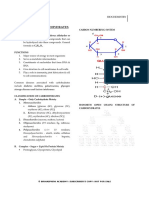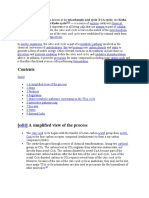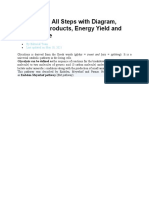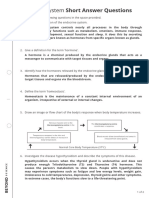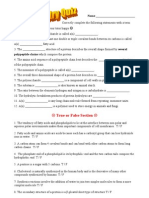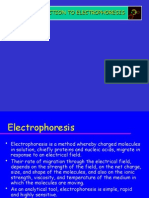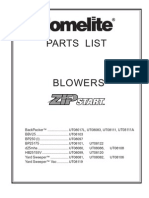Q.P. Code: 105001 Reg. No.: First Professional MBBS Degree Supplementary Examinations February 2017
Uploaded by
Aseem Bin MohammadQ.P. Code: 105001 Reg. No.: First Professional MBBS Degree Supplementary Examinations February 2017
Uploaded by
Aseem Bin MohammadQ.P. Code: 105001 Reg. no.
: …………………
First Professional MBBS Degree Supplementary Examinations
February 2017
BIOCHEMISTRY- PAPER I
Time: 3 Hours Total Marks: 50
• Answer all questions
• Draw diagrams wherever necessary
Essay (10)
1. Explain the oxidation of palmitate in mitochondria. Describe how the process is
regulated. Mention the number of high energy phosphate bonds generated in
palmitate oxidation (5+3+2=10)
Short essays (2x5=10)
2. Explain the digestion and absorption of proteins
3. What are enzymes. Explain briefly the factors affecting the velocity of enzyme
catalyzed reactions.
Short notes (5x3=15)
4. Mucopolysaccharides
5. Lipoproteins
6. Phenylketonuria
7. Glucose transporters
8. Trans methylation reactions
Answer briefly (5x2=10)
9. Uncouplers
10. Glutathione
11. Albinism
12. Galactosemia
13. Cori’s cycle
Give precise answers: (5x1=5)
14. Name the substrates for gluconeogenesis
15. Normal blood level of urea and glucose
16. Name the important compounds formed from glycine
17. Therapeutic uses of enzymes
18. Benedict’s test
***************
Sample output to test PDF Combine only
Q.P. Code: 105001 Reg. no.: …………………
First Professional MBBS Degree Examinations July 2017
BIOCHEMISTRY- PAPER I
Time: 3 Hours Total Marks: 50
• Answer all questions
• Draw diagrams wherever necessary
Essay (10)
1. Define enzymes. Classify enzymes according to IUB system with one example each.
Discuss about three enzymes commonly estimated after myocardial infarction.
(1+3+6=10)
Short essays (2x5=10)
2. Diagrammatic representation of mitochondrial electron transport chain and location of
ATP synthesis (3+2=5)
3. Define transamination and explain by giving two examples. (1+4=5)
Short notes (5x3=15)
4. What are lipotropic factors. Enumerate three lipotropic factors.
5. Phenylketonuria
6. Enumerate irreversible steps of glycolysis with the enzymes involved.
7. Functional classification of proteins.
8. Carnitine shuttle
Answer briefly (5x2=10)
9. Enumerate essential amino acids
10. What is HbA1C and mention its clinical importance.
11. Two co-enzyme roles of NADPH
12. Four functions of phospholipids
13.Define gluconeogenic. Name the fluconeogenic substrates
Give precise answers: (5x1=5)
14. Bond not broken in denaturation of protein
15. Enzyme deficiency in Cori’s disease
16. Plasma lipoprotein which is inversely correlated with coronary heart disease
17. One sulphur containing amino acid
18. Enzyme defect in alkaptonuria
***************
Sample output to test PDF Combine only
Q.P. Code: 105001 Reg. no.: …………………
First Professional MBBS Degree Examinations - August 2016
BIOCHEMISTRY- PAPER I
Time: 3 Hours Total Marks: 50
• Answer all questions
• Draw diagrams wherever necessary
Essay (10)
1. Trace the pathway of gluconeogenesis starting from alanine. Mention the key
enzymes and how they are regulated. (5+3+2=10)
Short essays (2x5=10)
2. Define carnitine and explain its role in oxidation of fatty acids.
3. Explain different types of enzyme inhibition giving suitable examples
Short notes (5x3=15)
4. Essential fatty acids.
5. Name different lipases involved in lipid metabolism and mention its functions .
6. Transamination
7. Heat coagulation
8. Michaelis Menten constant
Answer briefly (5x2=10)
9. Pro-enzymes
10. Invert sugar
11. Von Gierke’s disease
12. Essential pentosuria
13. Substrate level phosphorylation
Give precise answers (5x1=5)
14. Name the rate-limiting enzyme in fatty acid synthesis
15. What is GABA and mention its function
16. Mention the enzyme deficient in Tay Sach’s disease
17. Mention any two compounds derived from cholesterol
18. Name two carbon dioxide releasing steps in the TCA cycle.
***************
Sample output to test PDF Combine only
Q.P. Code: 105001 Reg. no.: …………………
First Professional MBBS Degree Supplementary Examinations -
February 2016
BIOCHEMISTRY- PAPER I
Time: 3 Hours Total Marks: 50
• Answer all questions
• Draw diagrams wherever necessary
Essay (10)
1. Mention the normal blood urea level. Add a note on formation & detoxification of
ammonia and the related disorders. (1+5+4= 10 )
Short essays (2x5=10)
2. Glucose transporters
3. Functions of phospholipids
Short notes (5x3=15)
4. Brown adipose tissue
5. Bile salts
6. Lipotropic factors
7. Pyruvate dehydrogenase complex
8. Isoenzymes
Answer briefly (5x2=10)
9. Mention the rate limiting step and the inhibitors of cholesterol synthesis
10. Enzyme defect and abnormal metabolites in phenyl ketonuria
11. Carnitine deficiency
12. Rapaport Leubering pathway
13. Specialized products of tryptophan
Give precise answers: (5x1=5)
14. Mention the features of classic galactosemia
15. Site of oxidation of very long chain fatty acids
16. Name the enzyme defect in Gaucher’s disease
17. Mention the enzyme is elevated in alcoholic cirrhosis
18. Name two uncouplers of oxidative phosphorylation
***************
Sample output to test PDF Combine only
Q.P. Code: 105001 Reg. no.: …………………
First Professional MBBS Degree Examinations - August 2015
BIOCHEMISTRY- PAPER I
Time: 3 Hours Total Marks: 50
• Answer all questions
• Draw diagrams wherever necessary
Essay (10)
1. Enumerate the components of electron transport chain. Describe the synthesis of
ATP. Indicate the site specific inhibitors. Mention two examples for uncouplers.
(4+2+2+2=10)
Short essays (2x5=10)
2. Gluconeogenesis
3. Diagnostic significance of serum enzymes
Short notes (5x3=15)
4. Digestion of carbohydrates
5. Essential fatty acids
6. Denaturation
7. Principle of chromatography
8. Name three glycogen storage diseases and its biochemical defect
Answer briefly (5x2=10)
9. Role of carnitine
10. Define isoelectric pH. State properties of a protein at its isoelectric pH
11. Importance of HMP shunt pathway
12. Sources of ammonia
13. Allosteric enzymes
Give precise answers: (5x1=5)
14. Name the biochemical defect in Nieman-pick disease
15. Zymogen activation
16. Mention the reaction catalyzed by ATP-citrate lyase
17. Mention two biologically active peptides
18. Mention one therapeutic use of enzyme
***************
Sample output to test PDF Combine only
Q.P. Code: 105001 Reg. no.: …………………
First Professional MBBS Degree Supplementary Examinations -
February 2015
BIOCHEMISTRY- PAPER I
Time: 3 Hours Total Marks: 50
• Answer all questions
• Draw diagrams wherever necessary
Essay (10)
1. Explain the reactions of glycogenesis and glycogenolysis in flow diagrams. Describe
how these processes are regulated. (4+4+2=10)
Short essays (2x5=10)
2. Describe the role of lipoproteins in cholesterol transport.
3. Chemiosmotic mechanism of ATP synthesis.
Short notes (5x3=15)
4. What is active methionine. Mention two examples of transmethylation reaction.
5. What is glucose alanine cycle and mention its significance.
6. Fatty liver
7. Name different types of specificity shown by enzymes with examples.
8. Denaturation of proteins.
Answer briefly (5x2=10)
9. Define Km value and state its importance.
10. What is the role of bile salts in fat digestion and absorption.
11. What is phenylketonuria and name the enzymatic defect.
12. Dietary fibre
13. Bence Jones protein
Give precise answers (5x1=5)
14. List two examples of mucopolysaccharides.
15. Name four essential amino acids.
16. Name two therapeutic enzymes.
17. List any four high energy compounds.
18.Mention the biochemical defect in fructosuria
***************
Sample output to test PDF Combine only
Q.P. Code: 105001 Reg. no.: …………………
First Professional MBBS Degree Examinations, August 2014
BIOCHEMISTRY- PAPER I
Time: 3 Hours Total Marks: 50
• Answer all questions
• Draw diagrams wherever necessary
Essay (10)
1. Define beta oxidation.Explain the reactions of beta oxidation of palmitic
acid.Add a note on its energetics (1+6+3=10)
Short essays (2x5=10)
2. Tricarboxylic Acid Cycle
3. Important compounds derived from glycine.
Short notes (5x3=15)
4. Enumerate three types of enzyme specificity.
5. Lactose intolerance.
6. Transamination
7. Significance of the HMP shunt
8. Uncouplers of oxidative phosphorylation
Answer briefly (5x2=10)
9. Active methionine
10. Biological action of glutathione
11. Hartnup’s disease
12. Clinical significance of ALP
13. Alkaptonurea
Give precise answers (5x1=5)
14. Name the deficient enzyme in Niemann Pick disease
15. Mention the normal level of serum creatinine
16. What is iso-electric pH
17. Mention any two key enzymes of glycolysis
18. Name four lipotropic factors
***************
Sample output to test PDF Combine only
Q.P. Code: 105001 Reg. no.: …………………
First Professional MBBS Degree Supplementary Examinations, February 2014
BIOCHEMISTRY- PAPER I
Time: 3 Hours Total Marks: 50
• Answer all questions
• Draw diagrams wherever necessary
Essay (10)
1. Explain in detail glycogensis and glycogenolysis. Mention the enzyme defects in any two
of glycogen storage disorders. (4+4+2= 10)
Short essays (2x5=10)
2. Name the ketone bodies. Describe the process of ketogenesis. List the conditions that
lead to ketoacidosis.
3. Mention the normal blood urea level. Explain how urea is synthesized in the body
Short notes (5x3=15)
4. What is meant by suicide enzyme inhibition. Explain with one example.
5. Discuss about phenyl ketonurias.
6. What are glycosamino glycans. List two examples with its functions .
7. Discuss the primary structure of human insulin.
8. Discuss the significance of gluconeogenesis
Answer briefly (5x2=10)
9. Functions of phospholipids
10. Name the poly amines and mention its functions.
11. Significances of km values.
12. Name the lung surfactant and mention its components
13. List the functions of Rapaport Leubering cycle.
Give precise answers: (5x1=5)
14. Why starch can be utilized by humans but not cellulose.
15. What are cathepsins.
16. List two clinical examples of competitive inhibition.
17. Why alcohol ingestion causes fatty liver.
18. List the compounds formed from arginine.
***************
Sample output to test PDF Combine only
Q.P. Code: 105001 Reg. no.: …………………
First Professional MBBS Degree Supplementary Examinations
January 2018
BIOCHEMISTRY- PAPER I
Time: 3 Hours Total Marks: 50
Answer all questions
Draw diagrams wherever necessary
Essay (10)
1. Name the site where beta oxidation of fatty acid occurs. Describe the steps involved in
beta oxidation of fatty acids. Explain how much energy is released in beta oxidation of
one molecule of palmitic acid. (1+6+3)
Short essays (2x5=10)
2. What are isoenzymes. Discuss the diagnostic importance of isoenzymes.
3. Discuss the regulation of glycogen metabolism
Short notes (5x3=15)
4. Glucose transporters
5. Mention the enzyme defective in galactosemia. Add a note on the clinical features of
galactosemia.
6. Formation and functions of nitric oxide.
7. ATP synthesis.
8. Monitoring of diabetes mellitus.
Answer briefly (5x2=10)
9. GABA.
10. Dietary fiber.
11. Primary hyper oxaluria
12. Mention the significance of hexose monophosphate shunt pathway.
13. Reverse cholesterol transport.
Give precise answers: (5x1=5)
14. Name two lipid storage disorders.
15. Name the vitamin and amino acid formed from tryptophan
16. Why sucrose is a non-reducing sugar.
17. Why orotic aciduria occur in type II hyper ammonemia
18.Name two acidic amino acids.
***************
Sample output to test PDF Combine only
Q.P.Code 106001 Reg. No.:…………………
First Professional MBBS Degree Supplementary Examinations
February 2017
BIOCHEMISTRY - PAPER II
Time : 3 hrs Max marks : 50
• Answer all questions
• Draw diagrams wherever necessary
Essay (10)
1. Mention the salient features of genetic code. Discuss in detail about the various types
of mutation. (3+7=10)
Short essays (2x5=10)
2. Un-conjugated hyperbilirubinemias
3. Plasma buffers
Short notes (5x3=15)
4. Thalassemias
5. Lesch Nyhan syndrome
6. Phase II reactions of detoxification
7. Wilson’s disease
8. Vitamin K cycle
Answer briefly (5x2=10)
9. Restriction endonuclease
10. Acute intermittent porphyria
11. Function and deficiency manifestations of vitamin E
12. Post translational modifications
13. Western blot technique
Give precise answers (5x1=5)
14. DNA helicase
15. Disorder of defect in excision nucleotide repair
16. Mention the copper containing enzymes
17. Hormones involved in regulation of blood calcium level
18. Bence Jones protein
***************
Sample output to test PDF Combine only
Q.P.Code 106001 Reg. No.:…………………
First Professional MBBS Degree Examinations July 2017
BIOCHEMISTRY - PAPER II
Time : 3 hrs Max marks : 50
• Answer all questions
• Draw diagrams wherever necessary
Essay (10)
1. Discuss the process of translation and add a note on post translational modifications.
(7+3)
Short essays (2x5=10)
2. Porphyrias presenting with photosensitivity
3. Metabolic acidosis
Short notes (5x3=15)
4. Sickle cell anemia
5. Gout
6. Phase I reactions of detoxification
7. Menke’s disease
8. Folate trap
Answer briefly (5x2=10)
9. Apoptosis
10. Factors influencing absorption of iron
11. Active forms of vitamin A and the deficiency manifestations
12. Post transcriptional modifications
13. Southern blot technique
Give precise answers (5x1=5)
14. Molecular scissors.
15. Disorder of defect in mismatch repair
16. Mention the zinc containing enzymes
17. Wobble hypothesis.
18. Mention the acute phase reactants
***************
Sample output to test PDF Combine only
Q.P.Code 106001 Reg. No.:…………………
First Professional MBBS Degree Examinations -August 2016
BIOCHEMISTRY - PAPER II
Time : 3 hrs Max marks : 50
• Answer all questions
• Draw diagrams wherever necessary
Essay (10)
1. Define transcription and explain in detail the transcription in prokaryotes. Add
a note on post transcriptional modifications (1+5+4=10)
Short essays (2x5=10)
2. Metabolic acidosis
3. Structure of immunoglobulin
Short notes (5x3=15)
4. Acute intermittent porphyria
5. Obstructive jaundice
6. Role of calcitonin in regulation of calcium homeostasis
7. Define tumor markers and mention four examples
8. Lesch Nyhan syndrome
Answer briefly (5x2=10)
9. Functions of vitamin K
10. Functions of magnesium
11. Four applications of recombinant DNA technology
12. Biochemical functions of thiamine
13. Mention two examples for detoxification by reduction
Give precise answers (5x1=5)
14. Important buffer in intracellular fluid
15. Co-enzyme form of pyridoxine
16. Major storage form of iron
17. Enzyme deficient in Wilson's disease.
18. The end product of purine metabolism in human
***************
Sample output to test PDF Combine only
Q.P.Code 106001 Reg. No.:…………………
First Professional MBBS Degree Supplementary Examinations -
February 2016
BIOCHEMISTRY - PAPER II
Time : 3 hrs Max marks : 50
• Answer all questions
• Draw diagrams wherever necessary
Essay (10)
1. Describe the salvage pathways for purine and pyrimidine synthesis. Explain the
biochemical basis of Lesch-Nyhan syndrome and Von Gierke’s disease. (5+5=10)
Short essays (2x5=10)
2. Define clearance and how it is estimated. Add a note on its diagnostic importance.
3. Genetic code.
Short notes (5x3=15)
4. Draw a neat labeled diagram of DNA structure
5. Role of kidney in blood pH regulation
6. Mitochondrial DNA
7. Enumerate three post translational modifications of proteins with one example
each
8. Principle of ELISA and two clinical applications in clinical diagnosis
Answer briefly (5x2=10)
9. One example each of detoxification by oxidation and conjugation
10. Enumerate two glomerular function tests
11. Enumerate primary and secondary bile acids
12. Four functions of plasma proteins
13. Two clinical conditions of hyper gammaglobinaemia
Give precise answers (5x1=5)
14. First pharmaceutical product of recombinant DNA technology for human use
15. Vitamin deficiency in beriberi
16. Anti hemorrhagic vitamin
17. Two radio isotopes used in the diagnosis and treatment
18. Active form of vitamin D
***************
Sample output to test PDF Combine only
Q.P.Code 106001 Reg. No.:…………………
First Professional MBBS Degree Examinations - August 2015
BIOCHEMISTRY - PAPER II
Time : 3 hrs Max marks : 50
• Answer all questions
• Draw diagrams wherever necessary
Essay (10)
1. Describe the process of transcription. What are the post transcriptional
modifications. Mention two inhibitors of transcription. (6+3+1=10)
Short essays (2x5=10)
2. Describe uric acid formation and mention the clinical significance of its
estimation.
3. Mention the normal level of serum calcium. Explain the hormonal regulation of
serum calcium
Short notes (5x3=15)
4. Acute intermittent porphyrias.
5. Mention the normal sodium level and clinical manifestation of hyponatremia.
6. Applications of radio activity.
7. Metabolic acidosis.
8. Creatinine clearance test.
Answer briefly (5x2=10)
9. List two reactions where the folic acid is the co-enzyme.
10. Principles of colorimetry.
11. How benzoic acid and sulfanilamide are detoxified in human body.
12. Explain why edema develops in hypo albuminemia.
13. List the different classes of immunoglobulins and mention the functional role of
any one.
Give precise answers (5x1=5)
14. List anti vitamins and mention one example.
15. Co-enzyme functions of biotin.
16. Name two biochemical markers of cancer.
17. Reverse transcriptases.
18. Proto-oncogenes.
***************
Sample output to test PDF Combine only
Q.P.Code 106001 Reg. No.:…………………
First Professional MBBS Degree Supplementary Examinations -
February 2015
BIOCHEMISTRY - PAPER II
Time : 3 hrs Max marks : 50
• Answer all questions
• Draw diagrams wherever necessary
Essay (10)
1. What is transcription. Enumerate the steps in transcription and add a note on post
transcriptional modifications (2+4+4=10)
Short essays (2x5=10)
2. How purine nucleotides are degraded. Add a note on abnormalities due to
excessive purine catabolism. ( 3+2=5)
3. Biochemical functions and deficiency manifestations of vitamin B12 (3+2=5)
Short notes (5x3=15)
4. Detoxification by conjugation
5. What are the salient features of genetic code
6. Respiratory acidosis
7. Name any two trace elements and mention the biological functions of each of
them
8. Functions of albumin
Answer briefly (5x2=10)
9. Salvage pathway of purine synthesis
10. Urea clearance test
11. Restriction enzymes
12. Acute intermittent porphyria
13. Principle of radioimmunoassay
Give precise answers (5x1=5)
14. Folate trap
15. Define BMR
16. What is ceruloplasmin.
17. Oncogenes
18. What is the normal serum level range of sodium and potassium
***************
Sample output to test PDF Combine only
Q.P.Code 106001 Reg. No.:…………………
First Professional MBBS Degree Examinations, August 2014
BIOCHEMISTRY - PAPER II
Time : 3 hrs Max marks : 50
• Answer all questions
• Draw diagrams wherever necessary
Essay (10)
1. Define replication. Describe in detail the replicative process in prokaryotes with the help
of diagrams (1+ 6+ 3= 10)
Short essays (2x5=10)
2. Discuss the structure and functions of Immunoglobulins
3. Discuss the co-enzyme role of thiamine and the deficiency disorder.
Short notes (5x3=15)
4. Differences between metabolic acidosis and respiratory acidosis.
5. PCR technique
6. Blood and urinary findings in various types of jaundice
7. List the functions of selenium.
8. Frame shift mutation
Answer briefly (5x2=10)
9. Calcitriol
10. Congenital erythropoietic porphyria
11. Wobble hypothesis
12. Spliceosomes
13. Creatinine clearance
Give precise answers (5x1=5)
14. Mention the normal serum albumin level and list two conditions where serum albumin is
decreased
15. Mention any two features of p53 gene
16. How glycine is used in detoxification reactions.
17. Enumerate the functions of zinc in the body.
18. Name the amino acids involved in the synthesis of pyrimidine
***************
Sample output to test PDF Combine only
Q.P.Code 106001 Reg. No.:…………………
First Professional MBBS Degree Supplementary Examinations, February 2014
BIOCHEMISTRY - PAPER II
Time : 3 hrs Max marks : 50
• Answer all questions
• Draw diagrams wherever necessary
Essay (10)
1. Describe the source, dietary requirements, biochemical functions and deficiency
manifestations of vitamin A. (1+1+4+4=10)
Short essays (2x5=10)
2. Explain briefly on blood buffers and add a note renal mechanism of maintaining acid
base balance. (2+3=5)
3. Describe the process of DNA replication. (5)
Short notes (5x3=15)
4. Abnormal hemoglobins
5. Tumor markers
6. Liver function tests
7. Immunoglobulins
8. Gene therapy
Answer briefly (5x2=10)
9. Folate antagonists
10. Normal serum concentration of sodium and potassium
11. ELISA ( Enzyme linked immunosorbent assay )
12. What is the normal serum calcium level. Name the hormones regulating serum calcium
13. Enzyme defect in lesch-nyhan syndrome and orotic aciduria
Give precise answers (5x1=5)
14. Deficiency of vitamin C
15. Examples for point mutation
16. What are BJP(Bence jones proteins)
17. Name two oncogenes
18. Normal serum uric acid level
***************
Sample output to test PDF Combine only
Q.P.Code 106001 Reg. No.:…………………
First Professional MBBS Degree Supplementary Examinations
January 2018
BIOCHEMISTRY - PAPER II
Time: 3 hrs Max marks : 50
Answer all questions
Draw diagrams wherever necessary
Essay (10)
1. Describe the sources, RDA, functions and deficiency disorders associated with
vitamin D. (1+1+4+4)
Short essays (2x5=10)
2. Porphyrias.
3. Describe post transcriptional modifications and its significance with examples.
Short notes (5x3=15)
4. Okazaki fragments.
5. Name three factors regulating plasma calcium levels
6. Chloride shift
7. Absorption of iron
8. Bence-Jones proteins
Answer briefly (5x2=10)
9. Ceruloplasmin
10. Fluorosis
11. Vanden Berg reaction
12. Base-pairing rule
13. Oncogenes
Give precise answers (5x1=5)
14. Name the deficient enzyme in Lesch-Nyhan syndrome
15. Mention the function of spliceosomes
16. Name two DNA repair mechanisms
17. Tumor markers
18. Albumin-globulin ratio
***************
Sample output to test PDF Combine only
QP Code 1501 Reg. No.:…………………
First Professional MBBS Degree Examinations - September 2011
BIOCHEMISTRY - PAPER I
Time : 3 hrs Max marks : 50
• Answer all questions
• Draw diagrams wherever necessary
Essay (10)
1. Define β-oxidation. Explain the reactions of β-oxidation of palmitic acid. Add a note
on its energetics. (2+5+3=10)
Discuss the following: (2x5=10)
2. Define and classify enzymes. Give one example for each class and mention the
reaction catalysed.
3. Define Urea cycle and describe the reactions of urea cycle.
Write short notes on: (5x3=15)
4. Phenylketonuria.
5. Classify lipoproteins and mention the function of each.
6. What is substrate level phosphorylation and mention two examples.
7. Define transamination and give two examples.
8. Define HMP shunt pathway and mention its significance.
Answer briefly: (5x2=10)
9. Name two plasma transport proteins and mention their role.
10. Mention two glycogen storage diseases with their deficient enzyme.
11. Write the clinical significance of glycated heamoglobin estimation
12. Name the bile salts and mention its functional significance
13. What is Gaucher’s disease. Mention two clinical features.
Give precise answers: (5x1=5)
14. Linkage present in sucrose.
15. Name two sulphur containing aminoacids.
16. Mention the enzyme defect in Galactosemia.
17. Mention the chemical name of lecithin.
18. Define Km value.
***************
Sample output to test PDF Combine only
Q.P.Code 106001 Reg. No.:…………………
First Professional MBBS Degree Examinations, August 2013
BIOCHEMISTRY - PAPER II
Time : 3 hrs Max marks : 50
• Answer all questions
• Draw diagrams wherever necessary
Essay (10)
1. Discuss in detail the mechanism by which kidney maintains the blood pH. What is meant
by metabolic acidosis and how it is compensated. (1+6+3=10)
Short essays (2x5=10)
2. Explain the degradation of haem
3. Discuss the process of transcription in prokaryotes
Short notes (5x3=15)
4. Cytochrome p450
5. List the different functions of plasma proteins.
6. Describe the Wald’s visual cycle.
7. Antioxidants
8. Discuss the base repair mechanism of DNA
Answer briefly (5x2=10)
9. Pellagra
10. Factors affecting iron absorption
11. DNA finger printing
12. Define gout and name three drugs used to treat gout.
13. Orotic aciduria
Give precise answers (5x1=5)
14. Mention two features of mitochondrial DNA
15. List the functions of restriction endonucleases.
16. Define tumor markers and mention one example
17.The normal albumin-globulin ratio and mention a condition in which it is reversed
18. Mention the examples of partially acceptable missense mutation and unacceptable
missense mutation
***************
Sample output to test PDF Combine only
QP Code 106001 Reg. No.:…………………
First Professional MBBS Degree Examinations, August 2012
BIOCHEMISTRY - PAPER II
Time : 3 hrs Max marks : 50
• Answer all questions
• Draw diagrams wherever necessary
Essay (10)
1. Describe the sources, RDA, biochemical functions and deficiency manifestations of
vitamin D. (2+1+5+2=10)
Short essays (2x5=10)
2. Describe the salvage pathway of purine nucleotide synthesis with its significance.
Describe the disorder associated with it.
3. Describe the structure and functions of tRNA.
Short notes (5x3=15)
4. Define metabolic acidosis. Mention the causes and biochemical finding in metabolic
acidosis.
5. Define replication and mention four inhibitors of replication.
6. Marasmus.
7. Mention the functions of zinc.
8. Cause and clinical features of acute intermittent porphyria.
Answer briefly (5x2=10)
9. Define nucleotide. Name two adenosine nucleotide derivatives.
10. Point mutation
11. Name the liver function tests.
12. Functions of biotin.
13. Define thalassemia and mention the different types of thalassemias.
Give precise answers (5x1=5)
14. Name two tumor suppressor genes.
15. Define genetic code.
16. Name two hormones causing increased levels of cyclic AMP.
17. Name the coenzyme required for transamination reactions.
18. Mention the normal serum calcium level.
***************
Sample output to test PDF Combine only
QP Code 1601 Reg. No.:…………………
First Professional MBBS Degree Examinations - September 2011
BIOCHEMISTRY - PAPER II
Time : 3 hrs Max marks : 50
• Answer all questions
• Draw diagrams wherever necessary
Essay (10)
1. Describe how protein is synthesized in body. Name any two inhibitors of protein
biosynthesis. Add a note on post translational modifications. (6+2+2=10)
Discuss the following: (2x5=10)
2. Outline the degradation of heme. Add a note on fate of conjugated bilirubin in
intestine.
3. Write briefly on storage and absorption of iron from intestine.
Write short notes on: (5x3=15)
4. What is gout. Mention the causes of primary gout.
5. What is the role of kidney in acid base regulation.
6. What are restriction endonucleases. What are their uses.
7. Write principle and application of polymerase chain reaction.
8. Write the structure of IgG molecule and indicate its function.
Answer briefly: (5x2=10)
9. Name the coenzyme forms of niacin and write important functions for each one
of them.
10. Wilson’s disease.
11. What is metabolic acidosis. Give one example of a disease associated with it.
12. Give two examples of detoxification by conjugation.
13. What is post hepatic jaundice. How is it diagnosed biochemically.
Give precise answers: (5x1=5)
14. What is provitamin. Give one example.
15. Clinical features of rickets.
16. Give one example for point mutation.
17. What are the enzymes commonly used in ELISA Technique.
18. Xeroderma pigmentosum is due to deficiency of what process.
***************
Sample output to test PDF Combine only
QP Code 106001 Reg. No.:…………………
First Professional MBBS Degree Supplementary Examinations, February 2013
BIOCHEMISTRY - PAPER II
Time : 3 hrs Max marks : 50
• Answer all questions
• Draw diagrams wherever necessary
Essay (10)
1. Describe how protein is synthesized in body. Name any two inhibitors of protein
biosynthesis. Add a note on post translational modifications. (6+2+2=10)
Short essays (2x5=10)
2. Outline the degradation of heme. Add a note on fate of conjugated bilirubin in
intestine.
3. Explain briefly on storage and absorption of iron from intestine.
Short notes (5x3=15)
4. Define gout. Mention the causes of primary gout.
5. Explain the role of kidney in acid base regulation.
6. List the restriction endonucleases and mention its uses.
7. Mention the principle and application of polymerase chain reaction.
8. Explain the structure of IgG molecule and indicate its function.
Answer briefly (5x2=10)
9. Name the coenzyme forms of niacin and write important functions for each one of
them.
10. Wilson’s disease.
11. What is metabolic acidosis. Mention one example of a disease associated with it.
12. List two examples of detoxification by conjugation.
13. What is post hepatic jaundice and how it is diagnosed biochemically.
Give precise answers (5x1=5)
14. Pro vitamin and mention one example.
15. Clinical features of rickets.
16. One example for point mutation.
17. Enzymes commonly used in ELISA technique.
18. Xeroderma pigmentosum is due to deficiency of.
***************
Sample output to test PDF Combine only
Q.P. Code: 105001 Reg. no.: …………………
First Professional MBBS Degree Examinations, August 2013
BIOCHEMISTRY- PAPER I
Time: 3 Hours Total Marks: 50
• Answer all questions
• Draw diagrams wherever necessary
Essay (10)
1. Discuss the metabolism of phenylalanine.
Short essays (2x5=10)
2. Digestion and absorption of lipids.
3. Describe glycogen metabolism.
Short notes (5x3=15)
4. Mutarotation
5. Essential fatty acids.
6. Isoenzymes.
7. Co-enzyme Q
8. Fate of pyruvate.
Answer briefly (5x2=10)
9. Regulation of cholesterol synthesis.
10. LDL receptor.
11. GABA
12. Albinism.
13. Ketogenic amino acids.
Give precise answers: (5x1=5)
14. What are epimers.
15. What is lecithin and mention its use.
16. Define iso-electric pH.
17.Name two transport proteins.
18. Mention two examples of biologically important peptides.
***************
Sample output to test PDF Combine only
Q.P. Code: 1501 Reg. no.: .................... .
First Professional MBBS Degree Supplementary Examinations, March 2012
BIOCHEMISTRY- PAPER I
Time: 3 Hours Total Marks: 50
• Answer all questions
• Draw diagrams wherever necessary
Essay (10)
t: Define Kreb's cycle. Describe the reactions of Kreb's cycle. Add a note on its
energetics and significance. (1+6+1+2=10)
Discuss the following: (2x5=10)
2. Describe the reactions of ketogenesis and its regulation.
3. Define secondary structure of proteins and mention its types. Describe about
a-helix.
Write short notes on: (5x3=15)
4. Define mucopolysaccharides and give two examples.
5. Describe the functions of mitochondria.
6. Define phospholipids and how are they classified.
7. Define feed back inhibition and give two examples
8. What are uncouplers . Give two examples
Answer briefly: (5x2=10)
9. Define epimers and give two examples
10. Define optimum pH and give one example
11. What are isomerases and give an example indicating the reaction catalysed
12.What is Cori's disease and mention the enzyme defect in it
13. Mention the four functions of albumin
Give precise answers: (5x1=5)
14. Name the defective enzyme in galactosemia
15. Name two polyunsaturated fatty acids
16. Define active site of an enzyme
17. Name two conditions causing increased urea level
18. Name the enzyme defect in Maple syrup urine disease
**************
Sample output to test PDF Combine only
Code: 105001 Reg. no.: …………………
First Professional MBBS Degree Examinations, August 2012
BIOCHEMISTRY- PAPER I
Time: 3 Hours Total Marks: 50
• Answer all questions
• Draw diagrams wherever necessary
Essay (10)
1. Mention the reactions by which glycine is synthesized and catabolized. Add a note
on the specialized products formed and mention the disorders associated with glycine
metabolism. (2+6+2=10)
Short essays (2x5=10)
2. Fatty acid synthase complex.
3. Describe the reactions of urea cycle. Discuss the interrelationship between urea
cycle and citric acid cycle.
Short notes (5x3=15)
4. Mention three examples of transmethylation reactions.
5. Ketosis
6. Secondary structure of proteins.
7. Importance of glutamine.
8. Covalent modification.
Answer briefly (5x2=10)
9. Hartnup’s disease.
10. Classification of glycolipids.
11. Uncouplers of oxidative phosphorylation.
12. Functions of cholesterol.
13. Significance of HMP shunt
Give precise answers (5x1=5)
14. Enzyme defect in maple syrup urine disease.
15. Epimer of glucose.
16. Normal level of serum albumin.
17. Name the biochemical test for phenylketonuria.
18. Important product of Rapaport- Leubering cycle in RBC
***************
Sample output to test PDF Combine only
QP Code: 105001 Reg. no.: …………………
First Professional MBBS Degree Supplementary Examinations, February 2013
BIOCHEMISTRY- PAPER I
Time: 3 Hours Total Marks: 50
• Answer all questions
• Draw diagrams wherever necessary
Essay (10)
1. Describe by a flow diagram the reactions of glycolysis giving names of enzymes
involved. Explain its regulation and add a note on the energetic in aerobic & anaerobic
conditions. (6+2+2=10)
Short essays (2x5=10)
2. What are essential fatty acids. Enumerate them. List two functions and one deficiency
manifestation. (1+2+2=5)
3. Explain the digestion and absorption of carbohydrates. (2+3=5)
Short notes (5x3=15)
4. Alpha helix
5. Explain, why blood is collected in a fluoride tube for glucose estimation.
6. Glucose Alanine cycle
7. Enzymes as markers of myocardial infarction
8. Transamination
Answer briefly (5x2=10)
9. What is substrate level phosphorylation. Mention one example.
10. What are lipotropic factors. Name any two lipotropic agents.
11. Four functions of cholesterol
12. Why TCA cycle is called amphibolic.
13. Two co-enzymes roles of NADPH
Give precise answers (5x1=5)
14. One therapeutic use of enzyme
15. Compound that facilitates the release of O2 from oxyhaemoglobin
16. Lipoprotein involved in reverse cholesterol synthesis
17. Enzyme deficiency in Mc Ardle syndrome
18. Enzyme defect in Lactose intolerance
***************
Sample output to test PDF Combine only
Q.P.Code 1601 Reg. No.:.................... .
First Professional MBBS Degree Supplementary Examinations - March 2012
BIOCHEMISTRY- PAPER II
Time: 3 hrs Max marks : 50
• Answer all questions
• Draw diagrams wherever necessary
Essay (10)
1. Describe about sources , RDA, biochemical functions and deficiency manifestations of
vitamin A. (1+1+6+2=10)
Discuss the following: (2x5=10)
2. Define protein energy malnutrition and compare marasmus and kwashiorkor
3. Describe the salvage pathway of purine nucleotide synthesis with its significance.
Describe the disorder associated with it.
Write short notes on: (5x3=15)
4. Describe any four functions of calcium
5. Structure of DNA
6. Define metabolic acidosis. Mention the causes and biochemical finding in metabolic
acidosis.
7. Define Reverse transcription and mention its significance
•
8. Name the tests to measure GFR and define creatinine clearance.
Answer briefly: (5x2=10)
9. Mention few unusual bases and mention where it is present.
10. Name the buffer systems in the body.
11. Mention the cause and clinical features of pellagra.
12.What is gout and mention few clinical features of gout.
13. Mention two diagnostic uses of radioactive isotopes.
Give precise answers: (5x1=5)
14. Name the hormones causing increased cyclic AMP production.
15. Enzyme used as tumor marker.
16. Mention the normal level of serum creatinine.
17. Mention the enzyme deficient in severe combined immunodeficiency disorder.
18.What type of mutation occurs in sickle cell anemia and what is the biochemical defect
in sickle cell anemia.
***************
Sample output to test PDF Combine only
You might also like
- Biochemistry II End of Semester Exam QuestionsNo ratings yetBiochemistry II End of Semester Exam Questions6 pages
- Medicinal and Environmental Chemistry: Experimental Advances and Simulations (Part I)From EverandMedicinal and Environmental Chemistry: Experimental Advances and Simulations (Part I)No ratings yet
- CHEM221 Biochemistry Practice Questions Chapters 1 and 2No ratings yetCHEM221 Biochemistry Practice Questions Chapters 1 and 217 pages
- SLG Chem 3 LG 5.3 Structure of Amino Acids and Levels of Protein StructureNo ratings yetSLG Chem 3 LG 5.3 Structure of Amino Acids and Levels of Protein Structure9 pages
- Full download Test Bank For Lehninger Principles of Biochemistry Seventh Edition pdf docx100% (13)Full download Test Bank For Lehninger Principles of Biochemistry Seventh Edition pdf docx49 pages
- Biochemistry Question Bank V 1.0e: Multiple Choice QuestionsNo ratings yetBiochemistry Question Bank V 1.0e: Multiple Choice Questions39 pages
- Biochemistry MCQ, Biochem by PQP, WWW - Pharmaquizportal.tk, Pharma Quiz Point & Pharma Quiz Portal100% (1)Biochemistry MCQ, Biochem by PQP, WWW - Pharmaquizportal.tk, Pharma Quiz Point & Pharma Quiz Portal10 pages
- Lipid and Amino Acid Metabolism: Chapter Objectives100% (1)Lipid and Amino Acid Metabolism: Chapter Objectives11 pages
- Test Bank For Lehninger Principles of Biochemistry Seventh Edition 2024 scribd download full chapters100% (4)Test Bank For Lehninger Principles of Biochemistry Seventh Edition 2024 scribd download full chapters55 pages
- (FREE PDF Sample) Biochemistry 7th Edition Mary K. Campbell Ebooks100% (6)(FREE PDF Sample) Biochemistry 7th Edition Mary K. Campbell Ebooks70 pages
- Proteins Covalent Structure - Biochemistry Questions and Answers - SanfoundryNo ratings yetProteins Covalent Structure - Biochemistry Questions and Answers - Sanfoundry1 page
- Biochemistry - 1st Year - Topical PapersNo ratings yetBiochemistry - 1st Year - Topical Papers18 pages
- Avatics 2017 03-02-15!34!57protein Synthesis Worksheet PracticeNo ratings yetAvatics 2017 03-02-15!34!57protein Synthesis Worksheet Practice2 pages
- Endocrine System Short Answer Questions - LA - AnswersNo ratings yetEndocrine System Short Answer Questions - LA - Answers2 pages
- Pre - Lab Practical 2: Organic Compositions of The CellNo ratings yetPre - Lab Practical 2: Organic Compositions of The Cell6 pages
- Download Study Resources for Test bank for Fundamentals of Biochemistry: Life at the Molecular Level 5th Edition by Voet100% (6)Download Study Resources for Test bank for Fundamentals of Biochemistry: Life at the Molecular Level 5th Edition by Voet49 pages
- Unit 3&4 Exercises Biochemistry 17.11.20No ratings yetUnit 3&4 Exercises Biochemistry 17.11.2036 pages
- Mycobacteria: Molecular Biology and VirulenceFrom EverandMycobacteria: Molecular Biology and VirulenceC. RatledgeNo ratings yet
- SAMI Ministar Recycling Instructions Rev CNo ratings yetSAMI Ministar Recycling Instructions Rev C18 pages
- Presentation On Turbine Protection System: Prepared by Subir Biswas100% (5)Presentation On Turbine Protection System: Prepared by Subir Biswas29 pages
- Soil Bearing Capacity and Modulus of Subgrade ReactionNo ratings yetSoil Bearing Capacity and Modulus of Subgrade Reaction16 pages
- SPE-195804-MS An Artificial Intelligence Approach To Predict The Water Saturation in Carbonate Reservoir RocksNo ratings yetSPE-195804-MS An Artificial Intelligence Approach To Predict The Water Saturation in Carbonate Reservoir Rocks15 pages
- 218 39 Solutions Instructor Manual Chapter 4 AccelerationNo ratings yet218 39 Solutions Instructor Manual Chapter 4 Acceleration25 pages
- Addressing the Microplastic Pollution A Societal ChallengeNo ratings yetAddressing the Microplastic Pollution A Societal Challenge21 pages
- Instant Download Internet of Things Global Technological and Societal Trends from Smart Environments and Spaces to Green Ict 1st Edition Ovidiu Vermesan PDF All Chapters100% (13)Instant Download Internet of Things Global Technological and Societal Trends from Smart Environments and Spaces to Green Ict 1st Edition Ovidiu Vermesan PDF All Chapters60 pages
- NOV 200T-5 Technical Data Sheets - UnlockedNo ratings yetNOV 200T-5 Technical Data Sheets - Unlocked2 pages
- Update Monte Carlo Tree Search (UMCTS) Algorithm For Heuristic Global Search of Sizing Optimization Problems For Truss StructuresNo ratings yetUpdate Monte Carlo Tree Search (UMCTS) Algorithm For Heuristic Global Search of Sizing Optimization Problems For Truss Structures25 pages
- Performance Analysis of Space Surveillance Using Space Based Optical SensorsNo ratings yetPerformance Analysis of Space Surveillance Using Space Based Optical Sensors11 pages
- Medicinal and Environmental Chemistry: Experimental Advances and Simulations (Part I)From EverandMedicinal and Environmental Chemistry: Experimental Advances and Simulations (Part I)
- CHEM221 Biochemistry Practice Questions Chapters 1 and 2CHEM221 Biochemistry Practice Questions Chapters 1 and 2
- SLG Chem 3 LG 5.3 Structure of Amino Acids and Levels of Protein StructureSLG Chem 3 LG 5.3 Structure of Amino Acids and Levels of Protein Structure
- Full download Test Bank For Lehninger Principles of Biochemistry Seventh Edition pdf docxFull download Test Bank For Lehninger Principles of Biochemistry Seventh Edition pdf docx
- Biochemistry Question Bank V 1.0e: Multiple Choice QuestionsBiochemistry Question Bank V 1.0e: Multiple Choice Questions
- Biochemistry MCQ, Biochem by PQP, WWW - Pharmaquizportal.tk, Pharma Quiz Point & Pharma Quiz PortalBiochemistry MCQ, Biochem by PQP, WWW - Pharmaquizportal.tk, Pharma Quiz Point & Pharma Quiz Portal
- Lipid and Amino Acid Metabolism: Chapter ObjectivesLipid and Amino Acid Metabolism: Chapter Objectives
- Test Bank For Lehninger Principles of Biochemistry Seventh Edition 2024 scribd download full chaptersTest Bank For Lehninger Principles of Biochemistry Seventh Edition 2024 scribd download full chapters
- (FREE PDF Sample) Biochemistry 7th Edition Mary K. Campbell Ebooks(FREE PDF Sample) Biochemistry 7th Edition Mary K. Campbell Ebooks
- Proteins Covalent Structure - Biochemistry Questions and Answers - SanfoundryProteins Covalent Structure - Biochemistry Questions and Answers - Sanfoundry
- Avatics 2017 03-02-15!34!57protein Synthesis Worksheet PracticeAvatics 2017 03-02-15!34!57protein Synthesis Worksheet Practice
- Endocrine System Short Answer Questions - LA - AnswersEndocrine System Short Answer Questions - LA - Answers
- Pre - Lab Practical 2: Organic Compositions of The CellPre - Lab Practical 2: Organic Compositions of The Cell
- Download Study Resources for Test bank for Fundamentals of Biochemistry: Life at the Molecular Level 5th Edition by VoetDownload Study Resources for Test bank for Fundamentals of Biochemistry: Life at the Molecular Level 5th Edition by Voet
- Exam Prep for:: Concepts in Transition Metal ChemistryFrom EverandExam Prep for:: Concepts in Transition Metal Chemistry
- Mycobacteria: Molecular Biology and VirulenceFrom EverandMycobacteria: Molecular Biology and Virulence
- Presentation On Turbine Protection System: Prepared by Subir BiswasPresentation On Turbine Protection System: Prepared by Subir Biswas
- Soil Bearing Capacity and Modulus of Subgrade ReactionSoil Bearing Capacity and Modulus of Subgrade Reaction
- SPE-195804-MS An Artificial Intelligence Approach To Predict The Water Saturation in Carbonate Reservoir RocksSPE-195804-MS An Artificial Intelligence Approach To Predict The Water Saturation in Carbonate Reservoir Rocks
- 218 39 Solutions Instructor Manual Chapter 4 Acceleration218 39 Solutions Instructor Manual Chapter 4 Acceleration
- Addressing the Microplastic Pollution A Societal ChallengeAddressing the Microplastic Pollution A Societal Challenge
- Instant Download Internet of Things Global Technological and Societal Trends from Smart Environments and Spaces to Green Ict 1st Edition Ovidiu Vermesan PDF All ChaptersInstant Download Internet of Things Global Technological and Societal Trends from Smart Environments and Spaces to Green Ict 1st Edition Ovidiu Vermesan PDF All Chapters
- Update Monte Carlo Tree Search (UMCTS) Algorithm For Heuristic Global Search of Sizing Optimization Problems For Truss StructuresUpdate Monte Carlo Tree Search (UMCTS) Algorithm For Heuristic Global Search of Sizing Optimization Problems For Truss Structures
- Performance Analysis of Space Surveillance Using Space Based Optical SensorsPerformance Analysis of Space Surveillance Using Space Based Optical Sensors











